
Way of Saint James
Way of Saint James
What to Do
Way of Saint James: 5 routes from Porto and Northern Portugal
From the 9th century, when the tomb of James the Great was identified, various paths and routes have emerged, traveled by pilgrims heading to Compostela. These pilgrimage routes – which are universal heritage of humanity – quickly assumed undeniable historical, spiritual, religious, cultural, and social importance.
The Way of Saint James, since time immemorial, has united people from different countries, social classes, and motivations, with a common purpose: to embark on a journey, both exterior and interior, which, it is said, will change you forever.
The North of Portugal embraces five routes, the Portuguese Ways, for pilgrims destined for Santiago de Compostela: the Coastal Way, the Central Way, the Inland Way, the Torres Way, and the Minhoto-Ribeiro Way. Join us on this journey.
1. The Coastal Way: 138 km
Itinerary: Porto, Matosinhos, Maia, Vila do Conde, Póvoa de Varzim, Esposende, Viana do Castelo, Caminha, Vila Nova de Cerveira, Valença.
Along the Portuguese Coastal Way, pilgrims, embraced by natural landscapes, immerse themselves in historical sites, guided by the accents and tones of welcoming people. The sea, mountains, and valleys frame the tradition, coexisting with vibrant streets and bustling historic centers.
Legend has it (from the 17th century) that on Bouças Beach (the old name for the city of Matosinhos) a miraculous encounter occurred between Cayo Carpo, also known as the “Knight of the Shells,” and the boat carrying the body of the Apostle James towards Galicia. This, they say, is how scallop shells became the symbol of St. James.
This route passes through Leça, land that was part of the Order of Knights Hospitaller (or Order of Malta). From the Monastery of Leça do Balio (located about 1.5 km from this Way), this Order welcomed and supported pilgrims heading to Santiago de Compostela, including royal figures such as King Afonso II.
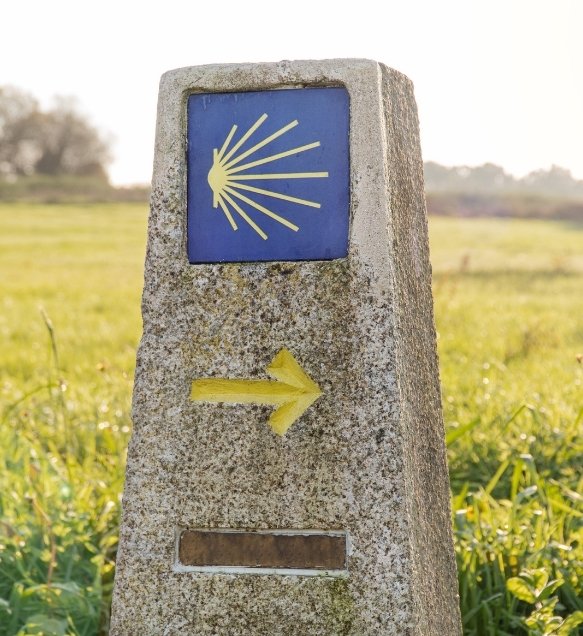
Did you know...
The Scallop Shell and the Yellow Arrow are symbols used to identify the Way of St. James, recognized worldwide.
Father Elias Valiña Sampedro is said to have started painting yellow arrows, initially to mark the French Way, in the 1970s.
2. Santiago Inland: 214 km
Itinerary: Viseu, Castro Daire, Lamego, Peso da Régua, Santa Marta de Penaguião, Vila Real, Vila Pouca de Aguiar, Chaves.
This Way extends through the inland part of the country. Starting in the Beiras and passing through the Douro, where the valleys and terraces are adorned with vineyards and olive trees, heading towards Trás-os-Montes. With its steep ascents and descents, it tests the physical prowess of those who traverse it, a challenge certainly compensated by the unforgettable scenery of this World Heritage Site.
This medieval route, which crosses 108 parishes in Portuguese territory, is presumably the oldest long-distance pilgrimage path from Portugal. It is currently one of the five Portuguese pilgrimage routes to Santiago proposed by the Portuguese Ministry of Culture to be recognized as a UNESCO World Heritage site.
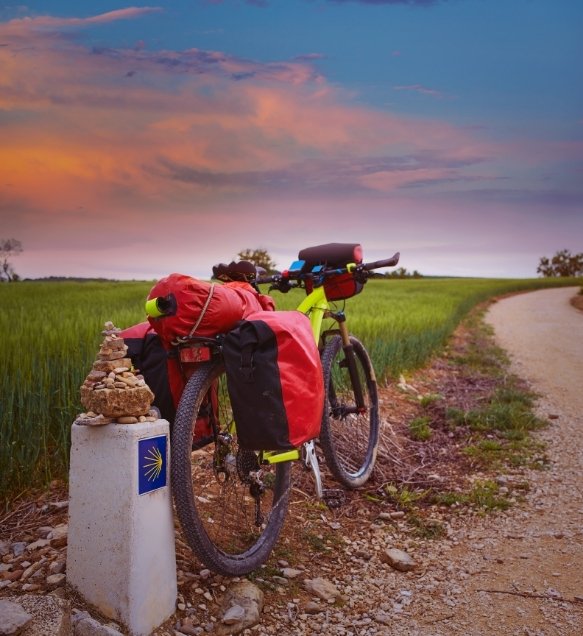
Did you know... there are bicigrinos?
For centuries, only the wealthiest people had the opportunity to travel the Way of St. James comfortably mounted on a pack animal. Nowadays, it is possible to do it by various means, including by bicycle. These pilgrims are known as bicigrinos.
3. Santiago Central - Primitive Way: 178 Km
Itinerary: Oliveira de Azeméis, São João da Madeira, Santa Maria da Feira, Vila Nova de Gaia, Porto, Matosinhos, Maia, Vila do Conde, Póvoa de Varzim, Barcelos, Ponte de Lima, Paredes de Coura e Valença.
The Central Way, filled with tradition, Minho estates and manor houses, roosters of Barcelos, legends and stories, is the most traveled route in the country.
Be sure to visit the Church of Rates. According to legend, Pedro de Rates, the first bishop of Braga, converted to Catholicism by St. James, was killed for attempting to convert the population to Christianity. He was said to have been buried in the village, in a small chapel, and later transferred to Braga. It was also here that the first modern hostel in Portugal was established.
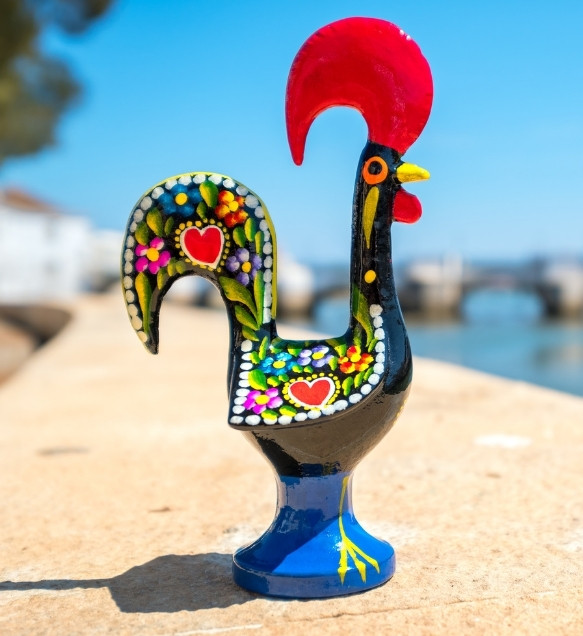
The legend of the rooster of Barcelos
Legend has it that a Galician man appeared in Barcelos and aroused suspicion. Despite pleading his innocence, the authorities arrested him, not believing that he was on his way to Santiago de Compostela or even that he was a fervent devotee of the Apostle.
Having been convicted, he asked to be taken to the judge before being hanged. The judge was in the middle of a banquet with friends, and the Galician man pointed to a roasted rooster and declared, “It is as certain that I am innocent as it is certain that this rooster will crow when they hang me.” His statement was met with ridicule, but the rooster ended up not being eaten, as none of those present dared to do so after what had happened. When he was about to be hanged, the roasted rooster stood up from the table and began to crow. They immediately ordered the Galician man to be released, and years later, he returned to Barcelos and built a monument in honor of St. James and the Virgin.
4. Torres Way: 234 Km
Itinerary: Sernancelhe, Moimenta da Beira, Tarouca, Lamego, Peso da Régua, Mesão Frio, Baião, Amarante, Felgueiras, Guimarães, Braga, Vila Verde, Ponte de Lima, Paredes de Coura, Valença.
This Way, named in honor of the writer Diego de Torres Villarroel, the most famous pilgrim, follows medieval roads. Simultaneously breathtaking and challenging, it takes you through steep climbs and urban centers, clear landscapes and traditions, six cathedrals, and four UNESCO World Heritage sites.
It is a journey of discovery, with eyes wide open: to the baroque of Amarante; to the façade of the main church of Sernancelhe, which holds the oldest sculptural representation of the Apostle James in Portugal; to the church and fountain of Santiago in Braga, and to the ancient monasteries and hostels where travelers once stayed. The representations of devotion to the Apostle and the historical significance of this route are astonishing.
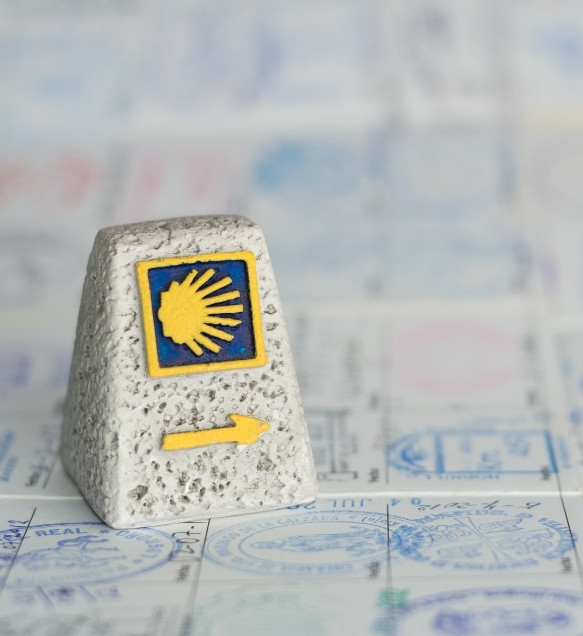
The pilgrim's credential and the Compostela
The credential is similar to a passport that pilgrims must stamp at each stage. The only official and valid credential is issued by the Pilgrim’s Office. It allows access to hostels and serves as certification of passage to request the Compostela at the end of the pilgrimage.
The Compostela is the document that certifies the completion of the pilgrimage. To obtain it, one must travel at least 100 kilometers on foot or horseback, 150 kilometers by bicycle, or 100 nautical miles by boat. It can be collected at the International Pilgrim Reception Center, at the headquarters of pilgrim confraternities, in hostels, parishes, and from associations of friends of the Way of St. James.
5. Minhoto Ribeiro: 123 Km
Main Itinerary: Braga, Vila Verde, Ponte da Barca, Arcos de Valdevez, Monção e Melgaço.
This is one of the oldest Portuguese Ways. Starting in Braga (Bracara Augusta in ancient times), it follows through Baixa Límia, passing through the stunning landscape of Serra do Gerês–Xurés, the welcoming Minho, and finally enters the lands of Ribeiro. Nature, thermalism, and wine are the three elements that make this route unique.
This path takes the pilgrim on a journey filled with castros and prehistoric populations, legends, megalithic settlements and burial mounds, stories, Roman roads, rural paths, and absolutely unforgettable landscapes.
Preparation for the Way of St. James
You can count on several companies that support pilgrims with everything they might need, such as Portugal Green Walks and Explore Iberia.
Whether you go solo or with support, here are some important things to keep in mind before setting off on the Camino:
- Prepare physically in advance. Pay special attention to muscle toning and flexibility. Start by walking daily, covering distances of 5 kilometers, and gradually increase them. Once you feel well-prepared, start doing daily routes with a backpack (with the approximate weight you will carry on the Way). Try different types of terrain and various routes.
- If you are older or have any medical conditions, consult your doctor before creating a suitable plan and defining situations to avoid.
- Develop a progressive plan that matches your physical capabilities. Respect your own pace. A Way Guide can be an excellent help.
- Prepare your backpack. Consider the weather forecast for the places you will pass through and adjust the clothing you will take.
- Consider applying for the European Health Insurance Card in advance.
What to pack in your backpack
Here are some essentials you should bring with you:
- Sandals, flip-flops, or sports shoes
- Boots
- Cotton and wool underwear and socks (seamless)
- Two pairs of pants
- Two short-sleeve shirts
- Two long-sleeve shirts
- Hat, visor or cap
- Sleeping bag
- Toilet paper and tissues
- Canteen
- High-factor sunscreen
- First aid kit (with band-aids, gel pads, tweezers, hypodermic needles, antiseptic or a similar product, painkillers, and anti-inflammatories)
- Documentation and credit cards (avoid carrying too much cash)
- Mobile phone, power bank, and charger
- Walking stick
Clothing should be appropriate for the time of year you decided to do the Way and the weather forecasts for the places you will pass through.
Optional items:
- Earplugs
- Flashlight
- Swimsuit
- Headscarf
- Basic kitchen utensils
- Detergent
- Lighter
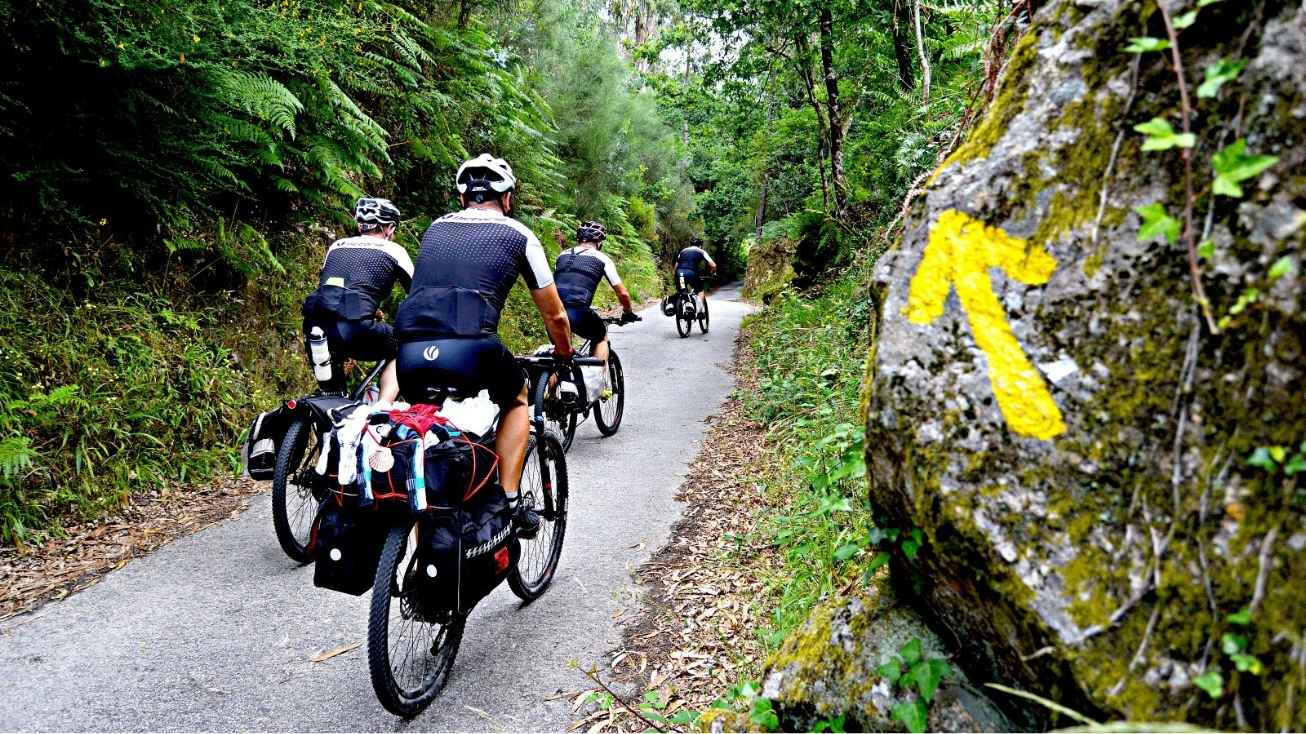
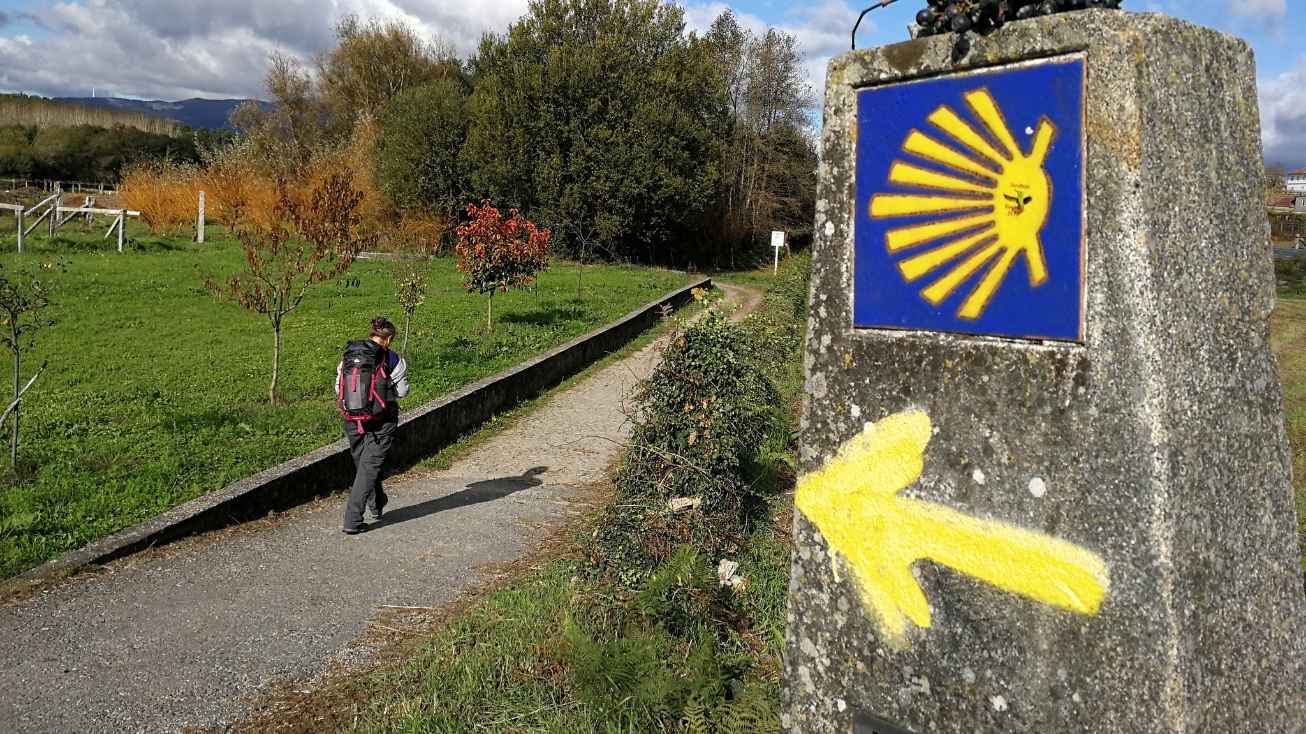
How to choose the best footwear for the Way of St. James
Choosing the right footwear for the Way of St. James is crucial. The right shoes help prevent injuries and other issues during the journey. Here are some tips and suggestions to help you make the best choices for your specific case:
- Do not use brand new shoes on the Way. If you buy new footwear, make sure to walk several kilometers in them beforehand.
- Select footwear for your step type: choose cushioning shoes (for supinators), stability control shoes (for neutral steps), and motion control shoes (for pronators).
- Choose footwear meeting key criteria: durable rubber sole, breathable material, adequate cushioning, comfort, and durability.
- Consider hiking boots, a good option for rainy days.
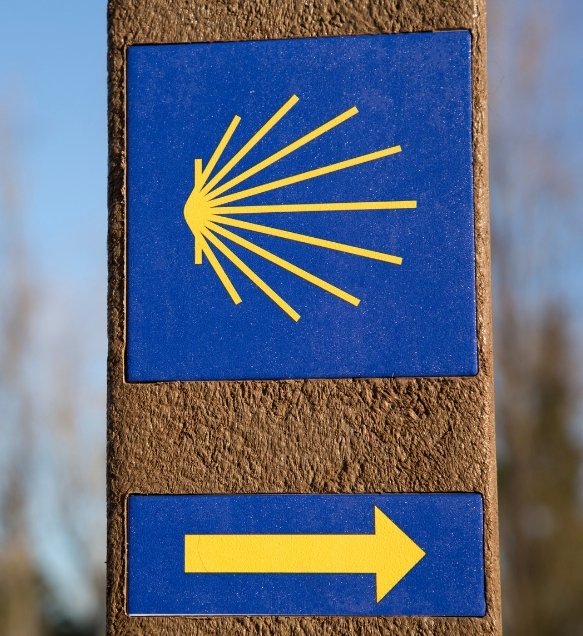
The Camino App
The Way of St. James App provides information on all the routes of the Way of St. James from the entry into Galicia. It is free and available for iOS and Android platforms.
It allows access to all information on the official routes of the itineraries; the official network of hostels and their characteristics, schedules, locations, phone numbers, and photos; information about events (festivals, concerts and more); suggestions for places to eat and what to visit; real-time weather conditions; contact information and addresses of health and emergency centers, among many others.
Have a great Camino!